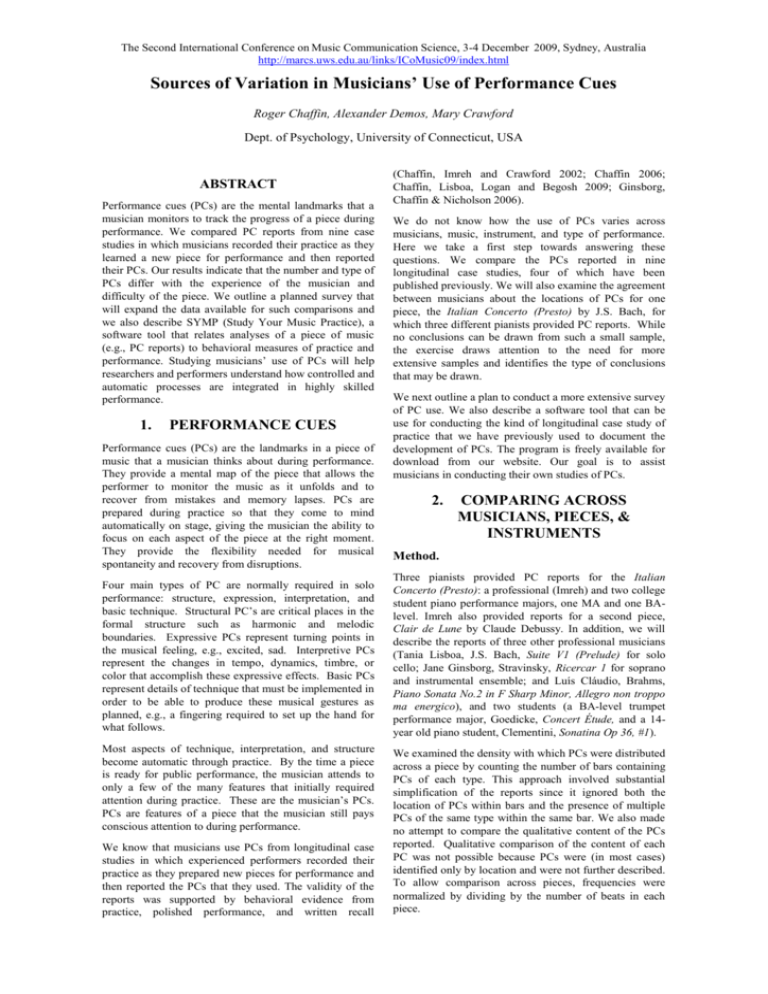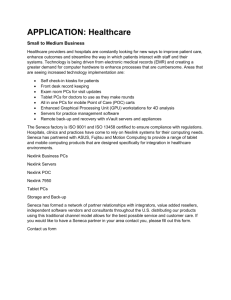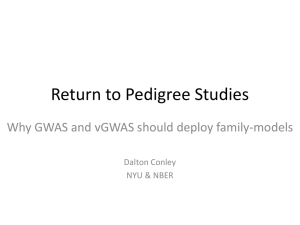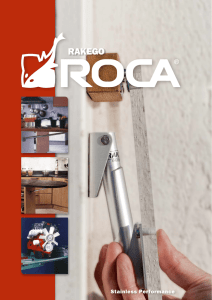Sources of variation in musicians` use of performance
advertisement

The Second International Conference on Music Communication Science, 3-4 December 2009, Sydney, Australia http://marcs.uws.edu.au/links/ICoMusic09/index.html Sources of Variation in Musicians’ Use of Performance Cues Roger Chaffin, Alexander Demos, Mary Crawford Dept. of Psychology, University of Connecticut, USA ABSTRACT Performance cues (PCs) are the mental landmarks that a musician monitors to track the progress of a piece during performance. We compared PC reports from nine case studies in which musicians recorded their practice as they learned a new piece for performance and then reported their PCs. Our results indicate that the number and type of PCs differ with the experience of the musician and difficulty of the piece. We outline a planned survey that will expand the data available for such comparisons and we also describe SYMP (Study Your Music Practice), a software tool that relates analyses of a piece of music (e.g., PC reports) to behavioral measures of practice and performance. Studying musicians’ use of PCs will help researchers and performers understand how controlled and automatic processes are integrated in highly skilled performance. 1. PERFORMANCE CUES Performance cues (PCs) are the landmarks in a piece of music that a musician thinks about during performance. They provide a mental map of the piece that allows the performer to monitor the music as it unfolds and to recover from mistakes and memory lapses. PCs are prepared during practice so that they come to mind automatically on stage, giving the musician the ability to focus on each aspect of the piece at the right moment. They provide the flexibility needed for musical spontaneity and recovery from disruptions. Four main types of PC are normally required in solo performance: structure, expression, interpretation, and basic technique. Structural PC’s are critical places in the formal structure such as harmonic and melodic boundaries. Expressive PCs represent turning points in the musical feeling, e.g., excited, sad. Interpretive PCs represent the changes in tempo, dynamics, timbre, or color that accomplish these expressive effects. Basic PCs represent details of technique that must be implemented in order to be able to produce these musical gestures as planned, e.g., a fingering required to set up the hand for what follows. Most aspects of technique, interpretation, and structure become automatic through practice. By the time a piece is ready for public performance, the musician attends to only a few of the many features that initially required attention during practice. These are the musician’s PCs. PCs are features of a piece that the musician still pays conscious attention to during performance. We know that musicians use PCs from longitudinal case studies in which experienced performers recorded their practice as they prepared new pieces for performance and then reported the PCs that they used. The validity of the reports was supported by behavioral evidence from practice, polished performance, and written recall (Chaffin, Imreh and Crawford 2002; Chaffin 2006; Chaffin, Lisboa, Logan and Begosh 2009; Ginsborg, Chaffin & Nicholson 2006). We do not know how the use of PCs varies across musicians, music, instrument, and type of performance. Here we take a first step towards answering these questions. We compare the PCs reported in nine longitudinal case studies, four of which have been published previously. We will also examine the agreement between musicians about the locations of PCs for one piece, the Italian Concerto (Presto) by J.S. Bach, for which three different pianists provided PC reports. While no conclusions can be drawn from such a small sample, the exercise draws attention to the need for more extensive samples and identifies the type of conclusions that may be drawn. We next outline a plan to conduct a more extensive survey of PC use. We also describe a software tool that can be use for conducting the kind of longitudinal case study of practice that we have previously used to document the development of PCs. The program is freely available for download from our website. Our goal is to assist musicians in conducting their own studies of PCs. 2. COMPARING ACROSS MUSICIANS, PIECES, & INSTRUMENTS Method. Three pianists provided PC reports for the Italian Concerto (Presto): a professional (Imreh) and two college student piano performance majors, one MA and one BAlevel. Imreh also provided reports for a second piece, Clair de Lune by Claude Debussy. In addition, we will describe the reports of three other professional musicians (Tania Lisboa, J.S. Bach, Suite V1 (Prelude) for solo cello; Jane Ginsborg, Stravinsky, Ricercar 1 for soprano and instrumental ensemble; and Luís Cláudio, Brahms, Piano Sonata No.2 in F Sharp Minor, Allegro non troppo ma energico), and two students (a BA-level trumpet performance major, Goedicke, Concert Étude, and a 14year old piano student, Clementini, Sonatina Op 36, #1). We examined the density with which PCs were distributed across a piece by counting the number of bars containing PCs of each type. This approach involved substantial simplification of the reports since it ignored both the location of PCs within bars and the presence of multiple PCs of the same type within the same bar. We also made no attempt to compare the qualitative content of the PCs reported. Qualitative comparison of the content of each PC was not possible because PCs were (in most cases) identified only by location and were not further described. To allow comparison across pieces, frequencies were normalized by dividing by the number of beats in each piece. The Second International Conference on Music Communication Science, 3-4 December 2009, Sydney, Australia http://marcs.uws.edu.au/links/ICoMusic09/index.html Results. The number of PCs increased with the experience of the musician and difficulty of the piece. Figure 1 shows the number of PCs of each type for each piece. The trumpet and grade-school students reported fewer PCs than other musicians by an order of magnitude. For the Presto, the two students reported fewer PCs than did the professional. The professional pianist (Imreh) reported fewer PCs for the easier (for her) Clair de Lune than for the challenging Presto. With the exception of the Presto, the four professionals all reported roughly similar numbers of PCs. learned the Prelude simply in order to add an important work to her repertoire. The pianist felt that her performance met her highest standard, whereas the cellist felt that her work on the Prelude would not be complete until she had all six movements of 6th suite ready for performance, something she did not intend to do during the time of the study. The difference in goals was reflected in the musicians’ practice strategies. The pianist began by mastering the technical challenges of the piece whereas the cellist gave priority to developing a satisfactory interpretation in time for the first public performance, delaying work on technical difficulties until late in the learning process (Chaffin et al., 2009). If this account is correct, then it suggests that the proportion of different types of PC is a sensitive indicator of musicians’ practice strategies. 3. Figure 1: Number of performance cues per beat for different musicians and pieces. COMPARING PCS FOR THE PRESTO ACROSS MUSICIANS Do different musicians use PCs in the same places when playing the same piece? The fact that our sample included three pianists who all reported PCs for the Presto provided an opportunity to address this question. We examined the extent to which the two students each agreed with the professional pianist, Imreh, on the location of bars containing each type of PC. Agreement was calculated using Cohen’s Kappa, which takes into account the probability of agreement due to chance overlap (Cohen, 1960). Kappa values larger than zero indicate above chance agreement levels. Figure 3 shows the agreement of each of the student musicians with the professional pianist, Imreh. The greatest agreement between the students and the professional was for musical structure. The MA and BA students had 88% and 83% of their structural locations overlapping with Imreh’s, respectively. Figure 2: Percent of PCs of each type (normalized over number of beats) for different musicians and pieces. Figure 2 shows the number of PCs of each type as a percentage of the total reported (normalized by number of beats). Experience mattered. The professionals used more basic PCs than any other type, while the college students used more interpretive PCs and the grade school student (and trumpeter) used more structural PCs. The differences may reflect that fact that the professionals had higher standards of technical competence for themselves whereas the grade school student and trumpeter had less detailed musical images for their performances. For the professionals, basic PCs made up 38-72% of the total number of PCs. The percentage of PCs was lowest for the Presto and highest for the Prelude. The comparison is instructive because both pieces received approximately the same amount of preparation, more than 30 hours of practice over many months. The difference between the two pieces may reflect differences in the strategies of the two musicians related to their goals for performance. Both undertook the self-study in order to develop their performance skills. The pianist, however, prepared the Presto for her first CD recording, an important step in her career. The cellist, in contrast, Figure 3: Amount of agreement each student had with the professional musician. The next highest agreement was for expressive PCs. The MA student agreed with Imreh on 100% of his expressive PCs. The BA student agreed with Imreh about 63% of hers. (The Kappa values in Figure 3 are lower than these percentages would suggest because Imreh had many more expressive PCs than the students). The students also agreed with each other about expressive PCs (Kappa=.296), but at a lower level than with Imreh. The students had lower levels of agreement with Imreh for interpretive and basic PCs. The MA student shared The Second International Conference on Music Communication Science, 3-4 December 2009, Sydney, Australia http://marcs.uws.edu.au/links/ICoMusic09/index.html 85% of his interpretive PC locations with Imreh and the BA student shared 78%. In the case of basic PCs, only the BA student had significant agreement with Imreh (82% overlap). Agreement for the MA student was lower (73%) and not significantly different from chance. The high level of agreement for expressive and structural PCs suggests that the musicians agreed in their assessment of the musical structure and the expressive turning points of the piece, despite differing levels of training and experience. The result is not surprising, because the location of expressive and structural PCs was driven by the relevant properties of the music. From this perspective, it is interesting that agreement about the musical structure was much higher than for expressive PCs. Even for structure, however, the musicians were far from unanimous. Each musician had a unique view of which locations in the musical structure were most important to attend to during performance. Figure 4 shows the extent to which the three pianists reported multiple PCs of different types in the same bars. For example, basic, interpretive, and expressive PCs at the same spot might reflect decisions to use the “1st finger” (basic) in order to play forte (interpretation), to create a “climax” (expression). The presence of the three different PC’s would provide the pianist with flexibility. On a good day, the pianist might decide to leave the fingering and the forte to take care of themselves in order to focus attention on the climax. On a bad day, the same pianist might fight to get the notes right and so decide to let the forte and climax take care of themselves in order to focus on the fingering. One benefit of well-prepared PCs is that they allow the musician to give very similar performances under different conditions, including changes in their own mental and emotional states. Multiple PCs in the same place provide the necessary flexibility. location just as often as she used only one kind of PC (2=.60, df=2, p=.74). The difference between the students and the professional suggests that the use of multiple PCs in the same location is characteristic of experts. Experts create flexibility in their performances by creating multiple PCs, while students rely more often on a single PC. PCs provide the musician with the ability to control the otherwise automatic motor sequences of their performance. Multiple PCs provide additional flexibility by allowing the performer to focus on different aspects of the music as the need or opportunity arises. 4. THE PC-SURVEY: EXTENDING THE COMPARISONS The comparisons we have made suggest that much may be learned by comparing PC reports. Reports from many more musicians are needed to answer the questions we began with. How is the number and type of PCs affected by experience, instrument, musical style, and type of performance? We are currently conducting a survey in which we ask musicians to report PCs for two pieces (one easier, one harder to prepare) that they have already prepared or are in the process of preparing for performance. Although we call it a “survey”, each musician’s contribution is a much-abbreviated version of the longitudinal case studies that we have used previously to establish that some musicians do use PCs. The main difference is that in the PC-survey the time consuming and demanding step of recording and transcribing practice is omitted. The change allows PC-reports to be collected in a period of days or weeks rather than months or years. We invite colleagues who are interested in contributing to the survey to contact us. More information about our studies of PCs is available on our website: http://www.htfdcc.uconn.edu/psyclabs/musiclab.html. 5. SYMP (STUDY YOUR MUSIC PRACTICE/PERFORMANCE) Also available for download on our website are the software tools used in our longitudinal case studies of how PCs develop. SYMP (Study Your Music Practice) makes these software tools available to musicians and researchers who want to engage in this kind of inquiry themselves. We have recently rewritten the tools in Microsoft Excel 2007, making them easier to use. They provide graphic summaries and descriptive statistics relating features of a piece of music to behavioral measures derived from its practice, performance, or recall. Figure 4: Percentage of PC type(s) used in the same measure of the music. The professional made much greater use of multiple PCs than the students. The student musicians tended to focus on only one type of PC at a time. The MA student used one PC per location about 80% of the time, and 2 or 3 concurrent PCs only 20% of the time (2=54.3, df=2, p<.001). The BA student used only one PC per location about 65% of the time, and 2 or 3 concurrent PCs 35% of the time (2=65.1, df=2, p<.001). The professional, in contrast, used 2 and 3 different types of PC at the same SYMP contains 5 modules. In the first module, the researcher enters bar-by-bar (or beat-by-beat) information about the music and its practice/performance into separate Excel spreadsheets. For PCs, the musician normally marks their locations on copies of the score. We later entered them into the spreadsheet. Information about practice or performance is entered into additional spreadsheets. Practice is represented by recording where playing started and stopped, performance by bar-to-bar measures of tempo or sound level, recall by measures of accuracy. Any behavioral measure of this sort can be used. The Second International Conference on Music Communication Science, 3-4 December 2009, Sydney, Australia http://marcs.uws.edu.au/links/ICoMusic09/index.html The other 4 modules provide statistical and graphical representations of the relationship between the musician’s reports and performance during practice or performance. Module 2 gives a graphical display of the measures practiced in each session. The example in Figure 5 shows a musician practicing a piece in sections and then playing through the entire piece without stopping. The figure reads from bottom to top with each horizontal, black line representing continuous playing of the corresponding measures. The figure also shows how practice can be related to the musical properties of a piece or to reports of PCs. In this example, the vertical green lines represent the boundaries between major sections. The last module can be used to extract predictors and dependent measures for use in regression analyses that can assess the reliability with which musical features and PCs are related to behavioral measures. 6. CONCLUSIONS In our longitudinal case studies, the experienced musicians engaged in extended practice of PCs. This suggests that PCs are necessary for reliable performance, perhaps because motor memory is unreliable (Chaffin et al., 2009). Our survey should identify the factors that affect PC use and establish the range of variability in the use of PCs. We hope that studies of PCs will become commonplace in music academies and departments. We believe that the reflection required provides musicians with insight into their own learning and memorization. All of the musicians who have participated in our longitudinal case studies have found the process to be beneficial (Chaffin et al., 2002, pp 266-268; Chaffin et al., 2009). In addition, we expect that such studies will contribute to improved pedagogy and to a better understanding of how controlled and automatic mental processes are integrated in highly skilled performance. Figure 5: Measures played in individual successive practice segments with Musical features/PC overlaid. Module 3 allows the investigator to view two additional charts. The first shows where playing started and stopped in each measure in one or more practice sessions. The second chart allows the user to see the number of times each measure was repeated, in one or more practice sessions. By selecting one or more musical features or PCs, the user can see how these relate to starts, stops and repetitions. In our own studies, we used charts like these to examine how the use of PCs in performance was prepared during practice. Although the musicians were typically not able to report the location of their PCs until around the time of the performance, the charts showed that groundwork had been prepared much earlier as musicians practiced attending to these features of the music during months of practice. Practice graphs like the one in Figure 5 provided a useful way of visualizing the relationship between the musicians’ practice and the features of the music that they identified in their reports. Module 4 allows the user to graphically track changes in practice across sessions. Any measure of practice can be tracked, such as tempo, amount of time practiced, the number of measures played overall, or the number played from memory. 7. ACKNOWLEDGEMENTS Thanks to Alexandra Paberty Clarke and Kristen Begosh for contributing data for the grade school student and trumpeter respectively. 8. REFERENCES Chaffin, R., Lisboa, T., Logan, T., and Begosh, K.T. (2009). Preparing for Memorized Cello Performance: The Role of Performance Cues. Music Psychology, in press. Chaffin, R., Imreh, G., and Crawford, M. (2002). Practicing perfection: Memory and piano performance. Mahwah, NJ: Erlbaum Associates. Chaffin, R. (2007). Learning Clair de Lune: Retrieval practice and expert memorization. Music Perception, 24, 377-393. Cohen, Jacob (1960), A coefficient of agreement for nominal scales, Educational and Psychological Measurement Vol.20, No.1, pp.37–46. Ginsborg, J., Chaffin, R., Nicholson, G. (2006). Shared performance cues in singing and conducting: A content analysis of talk during practice. Music Psychology, 34, 167-194.








